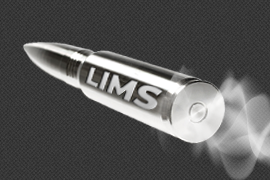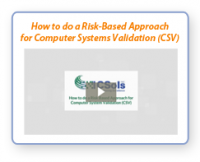The LIMS Silver Bullet
 Once you’ve been involved in the laboratory informatics world for some time, you’ll invariably run into situations where the belief that the cure for all the lab organization’s ills is to just put in a LIMS. Many even believe that all LIMS are the same so any LIMS will do. Got quality issues – put in a LIMS. Got regulatory compliance issues – put in a LIMS. Got productivity issues – put in a LIMS. We call this the belief in the “LIMS Silver Bullet”. Unfortunately, the truth of the matter is that while LIMS do have features, functions and capabilities that provide the means to overcome these challenges, your LIMS will need to be configured and properly implemented in order to meet your needs. Right out of the box, there really isn’t a LIMS Silver Bullet, however, planning, selecting, and then implementing the right LIMS for your lab organization, the right way, can be the best means of overcoming the challenges you’re facing and cure those ills once and for all.
Once you’ve been involved in the laboratory informatics world for some time, you’ll invariably run into situations where the belief that the cure for all the lab organization’s ills is to just put in a LIMS. Many even believe that all LIMS are the same so any LIMS will do. Got quality issues – put in a LIMS. Got regulatory compliance issues – put in a LIMS. Got productivity issues – put in a LIMS. We call this the belief in the “LIMS Silver Bullet”. Unfortunately, the truth of the matter is that while LIMS do have features, functions and capabilities that provide the means to overcome these challenges, your LIMS will need to be configured and properly implemented in order to meet your needs. Right out of the box, there really isn’t a LIMS Silver Bullet, however, planning, selecting, and then implementing the right LIMS for your lab organization, the right way, can be the best means of overcoming the challenges you’re facing and cure those ills once and for all.
Enhancing Quality with a LIMS
There are many features and functions that LIMS offer that can be utilized to enhance the quality of your lab processes, data, information and, of course, the quality of your product(s). Interestingly, when you analyze how LIMS affects quality, you will find that LIMS enhances the quality in labs through either the removal of human (i.e. scientist, technician, etc.) error or the enforcement of good laboratory practices and your approved SOPs via automation within the LIMS.
LIMS features, functions, and capabilities that enhance quality includes:
- Sampling Plan Automation
- Specifications management
- Automated calculations
- Automated workflows
- Automated limit checking (Pass, Fail, Warn, Trends)
- Significant figure support
- Instrument Calibration and Maintenance
- Instrument Integration and Automation
- Etc.
 A LIMS can, indeed, provide you with the means to improve and enhance your quality but you can only realize the quality benefits that a LIMS affords by properly planning and then implementing it. Because the old adage “Garbage In, Garbage Out” is very much applicable here; it’s imperative that you understand and clearly document how your lab operates (the workflows) and what the lab and its stakeholders’ data and information needs are. Then you will need to update and streamline your data needs, where applicable, and optimize your workflows and work processes. Remember, this cannot be done in a vacuum! Your LIMS team will need to work with all your stakeholders to gain consensus and buy-in for any changes and optimizations you decide on. Now armed with this information and a solid implementation plan, you will be able to realize these quality enhancements through implementing your LIMS.
A LIMS can, indeed, provide you with the means to improve and enhance your quality but you can only realize the quality benefits that a LIMS affords by properly planning and then implementing it. Because the old adage “Garbage In, Garbage Out” is very much applicable here; it’s imperative that you understand and clearly document how your lab operates (the workflows) and what the lab and its stakeholders’ data and information needs are. Then you will need to update and streamline your data needs, where applicable, and optimize your workflows and work processes. Remember, this cannot be done in a vacuum! Your LIMS team will need to work with all your stakeholders to gain consensus and buy-in for any changes and optimizations you decide on. Now armed with this information and a solid implementation plan, you will be able to realize these quality enhancements through implementing your LIMS.
Enhancing Regulatory Compliance with a LIMS
There are many features and functions that LIMS offer that can be utilized to enhance your adherence to the myriad of rules, regulations, and guidelines that apply in different industries (Medical Device, Environmental, Pharmaceutical, etc.).
LIMS features, functions, and capabilities that enhance regulatory compliance includes:
- Electronic signatures / Electronic records
- Review/Approve by Exception
- Audit Trail
- Standards and Reagents management
- Analyst Training Records management
- Automated Reporting / Ad-Hoc Reporting
- Etc.
 This is all well and good, however, how and to what extent an organization utilizes a LIMS’ regulatory compliance features and functions is highly dependent upon an organization’s appetite for risk and its interpretation of the regulations, as well as the type of science being conducted. It is critical that your organization has established its regulatory compliance policies, guidelines and practices so that you can apply these when determining what LIMS features you will implement and their priority. Moreover, if you need to validate your LIMS as per its intended use, you can leverage this information when performing your risk-based assessments.
This is all well and good, however, how and to what extent an organization utilizes a LIMS’ regulatory compliance features and functions is highly dependent upon an organization’s appetite for risk and its interpretation of the regulations, as well as the type of science being conducted. It is critical that your organization has established its regulatory compliance policies, guidelines and practices so that you can apply these when determining what LIMS features you will implement and their priority. Moreover, if you need to validate your LIMS as per its intended use, you can leverage this information when performing your risk-based assessments.
Enhancing Productivity with a LIMS
One of the main benefits of a LIMS is the increase in productivity their proper implementation can yield. Having grown up in this space, there are many capabilities that LIMS offer that can increase the productivity of your analysts, scientists, researchers and the lab operation itself. Productivity enhancement features within a LIMS will often be oriented towards the automation of complicated tasks/analyses or high volume, often repetitive, labor intensive tasks. Additionally, many productivity enhancing capabilities are designed to eliminate manual data recording, manipulation, and presentation tasks, as well as many laboratory record keeping chores (i.e. instrument logs, inventory logs). The theory being, of course, that by automating these processes, efficiency will be gained and productivity will be enhanced.
LIMS features, functions, and capabilities that enhance productivity includes:
- Instrument Interfaces
- System Interfaces (i.e. ERP, MES, PCS)
- Automated Dissolution Testing
- Stability Studies Module
- Automated calculations
- Automated workflows
- Automated limit checking (Pass, Fail, Warn, Trends)
- Review/Approve by Exception
- Automated Reports
- Instrument Calibration and Maintenance
- Freezer Management
- Inventory Management
- Etc.
 An interesting phenomenon is that while the savings driven by productivity enhancing capabilities are often the most utilized in justifying the procurement of a LIMS, they are often not implemented in the first phase of the project. Even more disturbing is that many LIMS projects never end up getting to phase 2 so these critical features and functions never get implemented at all. Care must be taken to properly plan the phases of your LIMS implementation project. Include a good number of these productivity enhancing features in phase 1. This will delight your users/scientists and enable you to leverage the cost savings that they generate as soon as possible, thereby shortening your ROI period.
An interesting phenomenon is that while the savings driven by productivity enhancing capabilities are often the most utilized in justifying the procurement of a LIMS, they are often not implemented in the first phase of the project. Even more disturbing is that many LIMS projects never end up getting to phase 2 so these critical features and functions never get implemented at all. Care must be taken to properly plan the phases of your LIMS implementation project. Include a good number of these productivity enhancing features in phase 1. This will delight your users/scientists and enable you to leverage the cost savings that they generate as soon as possible, thereby shortening your ROI period.
In other words, a LIMS, right out of the box, will not instantaneously enhance your quality or your regulatory compliance or your productivity. A good deal of effort is required to select, plan, and implement your LIMS so that you will be able to realize all these benefits.
Did you believe in the “LIMS Silver Bullet”? If so, do you still believe? Have you implemented a LIMS and been disappointed in what it did out of the box?
Comments